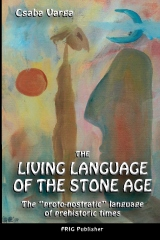|
The developing archaic Latin
To examine and prove the
distant but real and organic relations of languages is a very
difficult job. It is not our task to accomplish this in the
following chapters.
I won’t say that the
Latin and the Hungarian are sweet relatives. I say that many-many
Hungarian words and word-groups melted into the developing archaic
Latin language and this can easily be demonstrated:
One of many examples:
RÓZSA (Rose)
Cutting off roses in my garden, I got some long bloody streaks on my
forearms. This was the point, when I thought that rós(e) got its
name because it is “ró”-ing, it scratches with its thorns. This gave
me the motive to start looking for the way to prove, how rose and
other words landed in the ancient Latin language. How are words like
RÓzsa built in Hungarian?
Ró zsa is built like tor zsa <torža> (stalk, cob),
hor zsa <horža> (pumice),
mor zsa <morža> (crumb)
and rő-zse <roeže> (brushwood)
is even the same word with different pronunciation and modified
meaning.
After this
recognition we are trying to prove that the “ró” of the rózsa is the
same as all the other “ró”-s in our language, like
rovás <rovaash> (a way of writing, engraving)
rovatal > ravatal (catafalque)
rút (ugly)
rovott (person with criminal record)
The Latin words ROsa
(rózsa) and RUbor (redness) are scattered through Europe to
name a flower and a colour.
Other words built from RÚ are
RUga (wrinkle, face-line)
RUgo (puckers, crinkles)
Think of the picture:
a man’s wrinkled face full of grooves, in Hungarian REDő. (It
is interesting to meat the English word RED in this connection.) A
RÚT (very ugly) man has many wrinkles; his face has been
rótt, rútt (“scratched” a lot).
In case of RUScum (butchers
broom) the part “cum” means “with” and RUS means in Hungarian “rús”<ruush>
scratchy, thorny. In reality butchers broom has as many thorns as
roses.
This tells us with certainty that the Latin ROSa got its name,
because it has thorns and is RÓS <roosh> (scratchy). A
similar word is RUbetum (bramble-berry cane). It has thorns as well.
A ROStrum (beak) is able to RÓ (scratch).
Struma (goiter) is a
protruding growth. The root of this word is “trum”. A boulder is
MONS, a MONStrum is a monster. So we understand ROStrum better.
RUtrum can’t be anything else as a protruding something being able
to make grooves. It is a shovel, a spade.
We can state after all that the Latin ROSa got its name, because it
is “rós”, in other dialects “rús”, (thorny, scratchy) out of the
“Hungarian” language. The word RÓ (it scratches) is a verb. RÓS <roosh>
is its agglutinated form by the Hungarian way, is an adjective and
means scratchy, thorny. The “a” in ROSa points only to the feminine
gender.
Thus we can better
understand the following Latin words below:
RUS (ploughed land)
RUO (dig up, scratch)
RURICOLA (plowman, farmer)
RURIGENA (farmer)
RURO (farming)
RUSTICA (ill mannered (farmer) woman)
RUSTICANUS (plowman)
RUSTICITAS (rudeness)
RUSTICUS (ill-mannered man)
ROBUR (object made of oak)
We have to ask the question: was it possible that RO and RU was
taken from Latin into Hungarian? The answer is definitely NO. The
words RO and RU do not exist as basic roots in Latin, one cannot
explain those out of Latin. Only the Hungarian agglutinated forms,
ROS and RUS were used in Latin. Don’t forget, the Etruscans gave the
Romans the basic cultural contribution to their language, writing,
arts and manufacturing. These Etruscans spoke a “Hungarian” dialect
(Mario Alinei: “Etrusco: Una forma arcaica di ungherese”).
See further examples in the book: “The living language of the
Stone Age” by Csaba Varga

The
Living Language
of the Stone Age
Anima Könyv:
The Living Language of the Stone Age
(Eurasia’s Nostratic Language)
by Csaba Varga 2003 / 2009 |